Anatomy of a fire
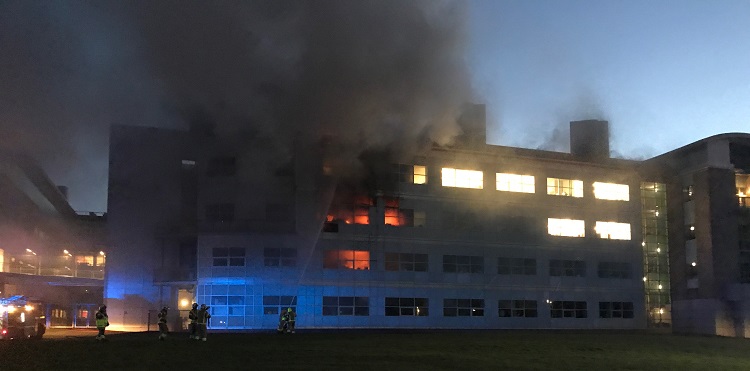
Fire never just burns. It rips and tears and blazes and guts. At least it did in the rash of headlines which accompanied Monday’s reports of the serious fire in our Biomedical Sciences Building on Sunday evening. With hindsight, the headline writers had a point.
The fire itself was confined to a small section of BMS, just a handful of rooms on the second, third and fourth floors – but it was the thousands of gallons of water used to extinguish the outbreak whose effects mean St Andrews has lost one of its most significant research buildings for a period of up to a year, perhaps considerably longer.
The fire managed to displace Brexit, for a few hours at least, closed the main road into St Andrews, needed 30 firefighters to bring it under control, and in a few short minutes had spawned one of the most complex and significant challenges our university will face this century.
It began on the third floor of BMS late on Sunday afternoon when a routine post-experiment wash-up went wrong. Colleagues followed safety procedures to the letter – a fire blanket was used immediately to try to extinguish the first flames in room 305, and when that failed they raised the alarm and evacuated.
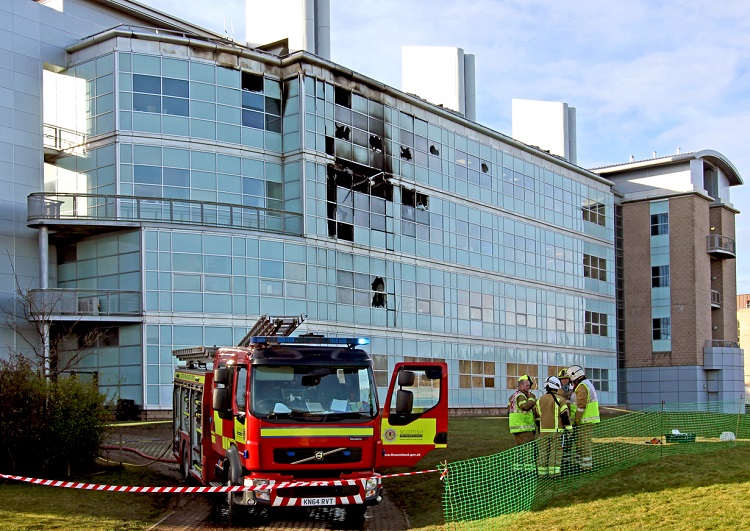
The fire brigade, who had been given full details of the nature of the outbreak and its exact location by the evacuees, were on scene within minutes.
Despite the speed of response, it was to take several hours to bring the fire under control.
The University’s major incident protocol was activated and the cafeteria in the Medical Building quickly became incident HQ. Smoke which had funneled through the air vents on the roof of BMS blanketed a windless North Haugh, while the University’s first-responders faced the inevitable fog of confusion in the early stages of the crisis.
Was there anyone still in the building? Would the quantities of chemicals in BMS pose a public health risk? Would we have to evacuate neighbouring buildings, including some of our biggest student residences? Where do you put hundreds of cold, displaced students on a winter’s night at short notice?
Confirming the safety of everyone in the BMS building was the top priority. The team worked through swipe card logs, checking names against a staff/student database and calling home numbers and mobiles for confirmation. Where a phone went unanswered, our security staff would go to that person’s home, knocking on doors to make contact.
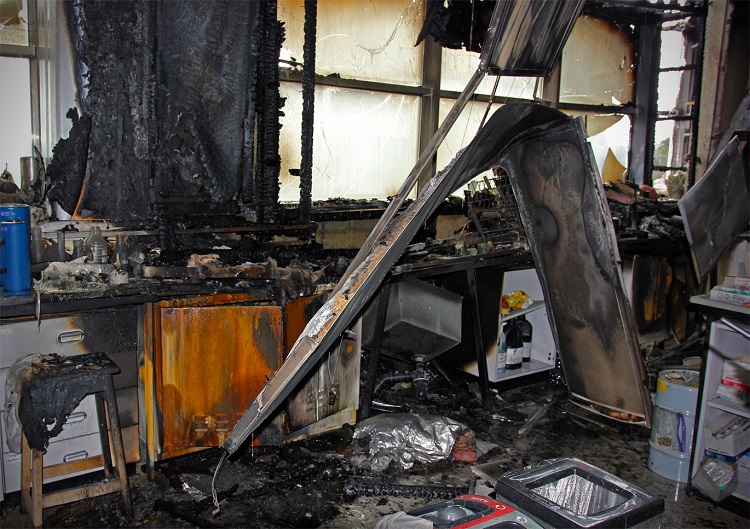
Meanwhile, knots of students and public formed close to the perimeter to watch the flames, despite warnings via the media that hazardous chemicals may be involved. Wardens were called to incident HQ, briefed and asked to tell students to return to their residences, and to keep windows closed. Some of those wardens then returned voluntarily to incident HQ to join the team calling mobiles and home numbers.
The swipe entry log sheets were cleared shortly before midnight – the strongest reassurance, short of a physical inspection of the burning building, that there had been no injury or loss of life.
An industrial consignment of burgers and chips arrived from Blackhorn, courtesy of the Director of Estates, while colleagues in RBS turned up with tea, coffee, water and more biscuits than was decent.
As Sunday slipped into Monday, the fire brigade announced the blaze had been extinguished and infra-red monitoring had revealed no significant hot spots. Concern lingered about the effects of chemical contamination however, and air quality monitoring and water sampling were carried out urgently. By 1.30am the brigade had confirmed no significant air quality issues.
The University trains for days like this. The teams who worked together on Sunday night – Estates, RBS, Communications, EHSS, Planning, IT Services, the Principal’s Office, Student Services and staff from Chemistry and Biology – are equipped by practice and previous experience to deal with the first fast-moving hours of a crisis.
In our midst however, senior academic colleagues from the Schools of Biology and Chemistry – who share the BMS Building – were turning increasingly concerned thoughts to the hours ahead.
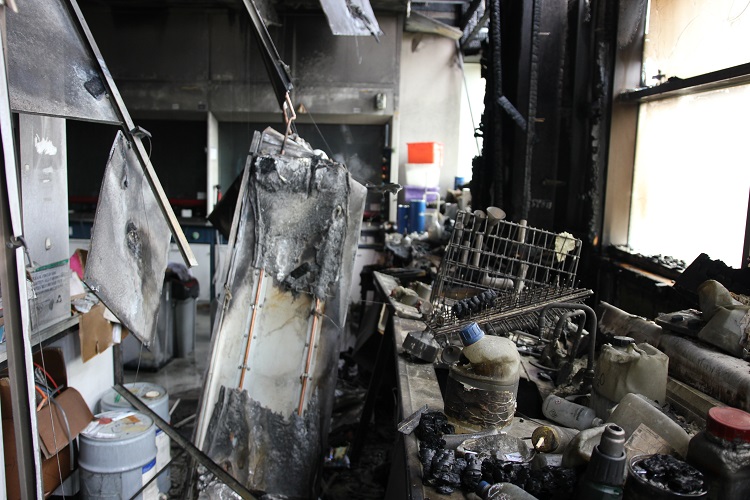
Built in the late 90s as a new model for interdisciplinary research, the four-storey BMS building houses labs conducting medically focused research in organic and synthetic chemistry, virology and microbiology. BMS is known as a centre of excellence addressing issues such as antibiotic resistance and infectious disease.
Its precious biological source material – central to all of that research – is kept in large freezers which maintain temperature at a constant minus 80.
If power to the building had been lost in the fire and flood, the freezers would quickly start to defrost.
Losing the freezers would mean losing the careers and futures of many of the 100 staff and postgraduate students who work in BMS. That simple.
Manufacturers estimated we had a maximum of 20 hours from loss of power to the point that rising temperatures would degrade the contents.
By 9am on Monday – 16 hours after the fire started – any relief we had felt at confirming no loss of life and the extinguishment of the fire was supplanted by the knowledge that we were in a race against the clock to rescue careers and a body of research whose loss would have been felt far, far beyond St Andrews.
Inside BMS, while the compartment design of the building had restricted the fire to just a few rooms, the vast quantities of water forced through the windows on Sunday evening had affected every level.
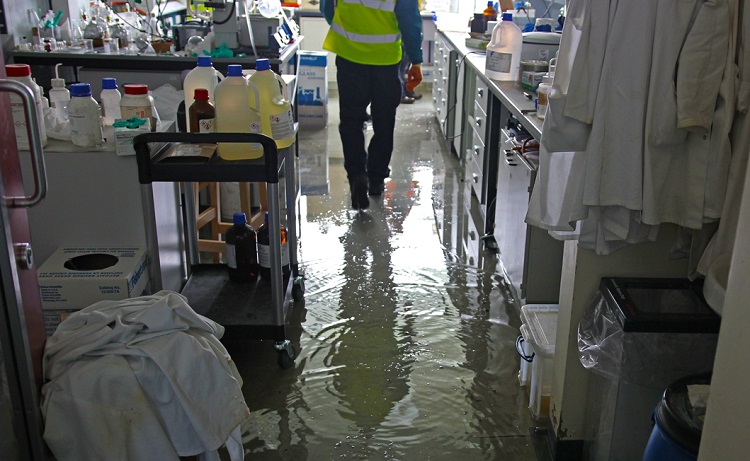
Monday midday and water was still pouring down the stairwells. Floors and electric cables lay under inches of water. Just getting in to the building safely was a challenge.
At 2.40pm, the fire brigade and our Estates colleagues cut all power to the building to limit the risk of electrocution.
A systematic rescue operation began. Academic colleagues kitted out in protective clothing, accompanied by EHSS and Estates staff and assisted by the fire brigade, were able to enter the building to start recovering the minus 80 freezers, moving them along corridors and to safety via the BMS exits to the Purdie Building.
Over the course of many hours, these teams recovered the vast majority of BMS refrigerated storage capacity, and with it the careers and the research critical to so many strands of microbiological and biomedical understanding.
The highest temperature found in any of the large freezers was minus 79. The relief felt at the success of this operation has however been tempered by the knowledge that not everything could be saved, and for some of our colleagues the fire will have been career limiting.
We are barely five days in from the outbreak. Our insurers have described the University’s response to the crisis thus far as “textbook”, a view which owes much to detailed ongoing management of the incident by senior colleagues in Estates.
Offers of practical help and moral support have been made to Chemistry and Biology by colleagues across St Andrews, and indeed from around the world. The collegial nature of the response has been instinctive, and in itself has played a key part in addressing the threat to morale.
While a huge amount has been achieved in a very short space of time, the tasks ahead of us as an institution and a community are daunting, complex and considerable. But they are achieveable.
BMS is extensively water damaged and will be out of action for at least a year, more likely longer. Options are being explored urgently to allow researchers to get back to fully equipped benches, with everything they require to continue their work, as soon as possible. BMS has been central to our identity as a research-intensive university for two decades.
The Principal and Quaestor will address a joint meeting of the Schools of Biology and Chemistry this afternoon to listen to concerns and questions, underline St Andrews’ commitment to restore what we had and discuss the options we are already looking at for providing timely access to lab facilities and equipment.

Category Community